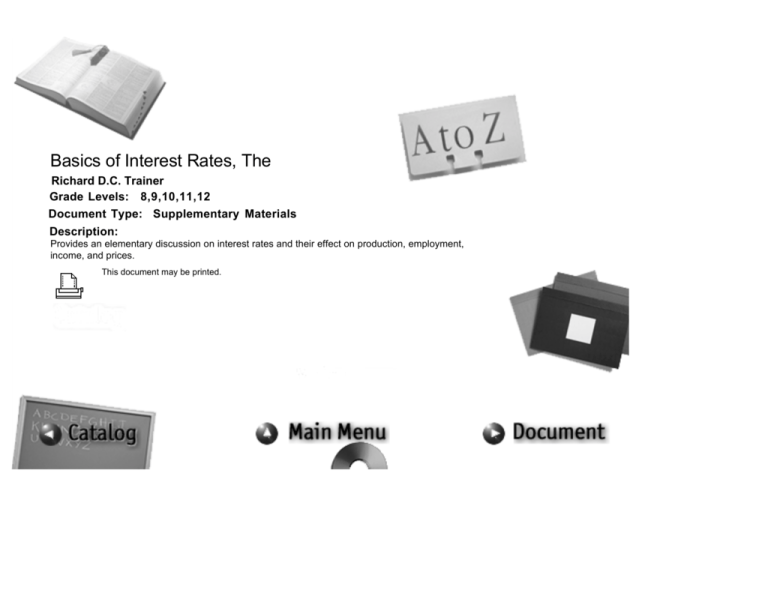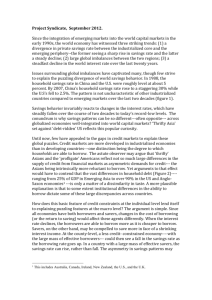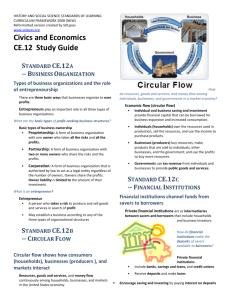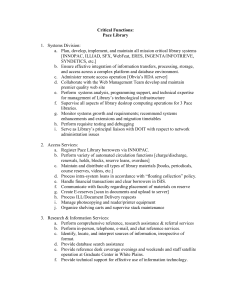The Basics of Interest Rates
advertisement

Basics of Interest Rates, The Richard D.C. Trainer Grade Levels: 8,9,10,11,12 Document Type: Supplementary Materials Description: Provides an elementary discussion on interest rates and their effect on production, employment, income, and prices. This document may be printed. INTRODUCTION Interest rates aren't what they used to be; rates a year or even a month ago are different from those prevailing today in our financial markets. That's because interest rates flex with the ebb and flow of general economic activity. Interest rates also change in response to the expectations borrowers and lenders have about the future level of prices. Changes in the dollar's value on foreign exchange markets or in interest rates abroad and, of course, the closely watched monetary policy actions taken by the Federal Reserve, all have a pronounced impact on the level of U.S. interest rates. There are, indeed, a host of factors that feed into determining the general level of interest rates. Interest rates play an important role in our market economy. As signals direct the flow of a city's traffic through a complicated grid of intersecting streets and avenues, interest rates channel the flow of funds from savers to borrowers. Usually, the funds flow through financial intermediaries such as banks, mutual funds and insurance companies. A balance is struck between the demand for funds by borrowers and the supply of funds from savers by an ever-adjusting level of interest rates. Changes in the quantity of funds available to finance the spending plans of borrowers as well as changes in borrowers' demands for funds alter interest rates which, in turn, affect the levels of consumer and business spending, income, the Gross National Product, the employment of resources and the level of prices. Clearly, interest rates have a tremendous effect on our economy. This booklet is not intended to be a primer on interest rate forecasting. Nor does it reveal magic formulas for achieving the "right" level of interest rates for our economy, if such a level actually exists. Instead, the booklet describes, at an elementary level, the meaning of interest rates; the demand for and supply of credit; the principal credit market participants; the effect of interest rates on the decisions we make concerning spending and saving, and lending and borrowing; and the ultimate effect of interest rates on the health and vitality of the economy. THE BASICS Neither a borrower, nor lender be; For loan oft loses both itself and friend, And borrowing dulls the edge of husbandry. --Shakespeare, Hamlet Borrowers in search of. . . Most of us are borrowers. We take on debt in various forms for a variety of reasons. Consumers, for example, borrow for short periods of time when they use credit cards instead of cash to make purchases. Households also borrow for periods of up to thirty years when financing purchases of homes. Business firms often incur debt when acquiring equipment or when modernizing or building factories. And, of course, governments borrow to cover the excess of their expenditures over their income from the collection of taxes and other fees. While the absolute level of borrowing by the household, business and government sectors has risen steadily with the growth of the economy, each sector's share of the total amount borrowed has, on average, remained fairly constant. Each sector of the economy can borrow in our financial markets, reasonably confident the funds will be available. But what if we lived in an economy without financial markets and institutions to provide borrowers with the funds they demand? A business firm, for example, couldn't readily borrow to acquire a new piece of equipment that would lower its production costs. To finance the acquisition, it would have to turn to its own resources by saving, or retaining a fraction of its income, until it accumulated enough funds to make the desired investment. That might take some time, especially if the equipment were relatively expensive or if the firm's annual cash resources from the sale of its output were too limited or uncertain. An economy without financial markets and institutions to facilitate the financing of spending or investment opportunities would have lowered prospects for economic growth, development and increased well-being for its citizens. . . . savers in search of. . ., We save when the level of our income exceeds expenditures. Consumers are habitual savers; in fact, on balance, they generally save more than they borrow. Motivated to save by a variety of economic and non economic factors, consumers not only hold their savings in traditional forms such as savings deposits at banks or thrift institutions and U.S. savings bonds but in corporate stocks, bonds and pension or retirement plans, as well. Business firms also save when they retain the profits remaining after business-related expenses, taxes and dividend payments to shareholders have been deducted from revenue. Business retained earnings are often placed temporarily in bank deposits or used to purchase shortterm investments until the funds are needed to finance expenditures such as the acquisition of equipment. Unlike consumers, however, businesses generally borrow more than the amount they save. Finally, governments -- federal, state and local -- may save. Fiscal surpluses are generally characteristic of state and local governments; that is, their cash receipts from taxes and fees usually exceed their expenditures. The federal government, however, has been a net borrower of funds in financial markets, with budget deficits the rule rather than the exception. Without organized financial markets, savers wouldn't have an outlet for their funds, nor would borrowers have ready access to the funds they wanted. Any saving probably would be by those interested in financing their own future spending needs. Again, without a mechanism to channel the excess funds of savers to meet the financing needs of borrowers, an economy would find it difficult to grow. . . . a rate of interest. Interest rates are the signals that affect the channeling of funds to demanders or borrowers from suppliers or savers, directly or through financial intermediaries. Since interest rates and time are closely related, the expression that "time is money" is helpful in understanding the financial demandsupply linkage and, in turn, the determination of interest rates. Assume there are only two individuals. Each earns income and pays taxes. One individual decides to spend less than her after-tax or disposable income, while the other would like to spend more than his disposable income. The second individual can accomplish his spending objective only if he can find a source of financing, either from his own resources or from those of others. Let's assume that the necessary financing takes the form of a loan directly from the first individual. Normally, such a loan would be made only if the lender is reasonably assured of two things: one, that the amount borrowed, or the principal, will be repaid at the end of an agreed-upon period of time; and two, that the total amount the borrower promises to repay is greater than the principal, thereby compensating the lender for giving up the use of her money for an amount of time. Even if there were little or no risk of the principal not being repaid, the lender would still require something in return from the borrower if she's to be coaxed into foregoing the use of some of her disposable income for current spending. While making the loan reduces her spending now, the receipt of interest from the borrower would enable her to increase her spending later on. A lender's requirement to be compensated, and a borrower's agreement to make that compensation, whenever money and financial claims, or IOUs, change hands for a period of time, is what interest and interest rates are basically all about. FINANCIAL INTERMEDIARIES Financial markets, as with any other market, must have two dimensions: a demand side and a supply side. One without the other will not make a market. In the two-person example, the funds demanded by a borrower were supplied directly by a lender-saver. But, in fact, most financial transactions occur indirectly through intermediaries such as banks, thrift institutions, insurance companies, and pension and retirement funds. While the share of lending by financial intermediaries has been declining, intermediaries still provide the bulk of funds to borrowers. Direct lending from households and foreigners. for example, has increased. Financial intermediaries basically are dealers in financial claims or debt--their own and that of others. Their business is to transmit the flows of funds from those who have more funds to invest to those with a shortage who must pay for their use. Intermediation is a two-step process. First, an intermediary, say a bank, obtains funds from savers in the form of deposits. In exchange, the bank issues a financial claim representing its obligation to repay the deposited funds or to transfer them to others at the depositor's request. Second, the bank uses the acquired funds to purchase the financial claims of others. Examples of these claims include loans to consumers and businesses, and securities or IOUs of federal, state or local governments. Intermediation, then, provides savers with an outlet for their funds while simultaneously providing funds to borrowers to finance their spending plans. Dealing in debt and funds generally involves both the payment and receipt of interest. If the interest an intermediary earns on the funds it lends to borrowers is greater than what it has to pay to acquire funds from savers, a profit is earned for its intermediation. If, on the other hand, there is a negative spread or difference between what an intermediary receives on its portfolio of borrowers' IOUs and what it has to pay to attract funds from savers, the intermediary loses money. To remain in business and stay competitive, an increase in an intermediary's cost of funds will require it to acquire higher yielding financial claims. In other words, if intermediaries pay more to attract and retain funds, so must borrowers. The process of intermediation can be demonstrated by looking at the changes that take place in a financial intermediary's balance sheet over a period of time. An intermediary's balance sheet is a financial snapshot describing its assets, or the value of what it owns, including its holdings of the financial claims of others; its liabilities, or the value of its own financial obligations to others; and its equity or net worth, or the value of what it owns in relation to what it owes. Changes in an intermediary's financial assets--the uses to which it puts its acquired funds-and changes in its liabilities--the sources of its funds--are important elements in explaining both the level and changes of interest rates. The following table shows several financial intermediaries, and their major sources and uses of funds. Major Sources of Funds • Customer deposits Intermediary • Banks • Customer deposits • Thrifts • Policy premiums and earnings from financial investments • Insurance companies • Employer and employee contributions • Pension funds • Shares • Money market funds • Commercial paper and bonds Finance companies Major Uses of Funds • Business and consumer loans, mortgages, and securities of federal state and local governments. • Consumer loans, mortgages and securities of federal, state and local governments. • Securities of business corporations and federal state and local governments. • Securities of business corporations and federal state and local governments. • Securities of business corporations and federal state and local governments. • Consumer and business loans, and mortgages. As the table shows, financial intermediaries generally obtain their funds from savers. However, they use funds to meet the borrowing needs of different sectors of the economy. While most intermediaries use a portion of their funds to lend to the government sector by purchasing Treasury securities and state and local government bonds, some are more specialized in their lending. Thrift institutions, for example, use their funds primarily to acquire financial obligations of consumers, namely home mortgages and automobile loans. Pension funds and insurance companies, on the other hand, use much of their acquired funds to extend credit to business firms by purchasing corporate stocks and bonds. MATURITY Consumers, business firms and governments borrow funds for different periods of time. Generally, the maturity of a borrower's IOU depends on the nature of the expenditures being financed. For example, consumer purchases of homes are usually financed with mortgages that run fifteen or thirty years, while items with shorter useful lives such as automobiles and home appliances are financed with much shorter-term loans. Business borrowings also cut across the time spectrum. Loans as short as several days to meet day-to-day cash needs or for as long as thirty years to finance new factories are common. And, of course, governments borrow for periods as short as a few days to raise cash in anticipation of tax receipts as well as for much longer periods when financing the construction of college dormitories, bridges and highways. IOUs with original maturities of one year or less are exchanged for funds in the money market. For example, the U.S. government obtains a large part of its funds from the money market each week when it sells Treasury bills with three- and six-month maturities. Some borrowers, on the other hand, tap funds from the capital market where they issue IOUs with original maturities in excess of one year. Examples of capital market borrowings include the issuance of five-year Treasury notes and twenty-year corporate bonds. Interest rates in the money and capital markets are related and usually move in the same direction. In addition, rates on short-term financial instruments are often lower than those on longer term IOUs issued by the same borrower. While all lenders have an eye to the future, their understanding standing of the present is more complete and uncomplicated by longer-term uncertainties. Therefore, it is usually the case that the longer the maturity of an IOU, that is, the longer the time period for which funds are borrowed, the higher the interest rate demanded by lenders will tend to be. RISK AND UNCERTAINTY Both borrowing and lending typically involve a degree of risk and uncertainty which are reflected in the level of interest rates as well as in the tempo of activity in financial markets. Not being repaid, receiving only partial payment or receiving payment whose purchasing power has diminished are some examples of the risk and uncertainty surrounding financial activities. Since a borrower repays the principal and interest in money, inflation over the course of the loan will make the amount the lender receives worth less in terms of the goods and services money can buy. Lenders typically estimate an expected rate of inflation and try to protect themselves against money's loss in value by requiring a premium related to that expectation. This premium, of course, is in addition to what lenders normally require as compensation for making loans. The greater the inflationary expectations in the financial markets, the greater the premium borrowers would have to pay if they hope to obtain funding. Borrowers and lenders typically formulate their expectations of future inflation on the basis of their experience with past and present rates of inflation; other factors such as the outlook for energy prices or monetary policy may also play a role. A rise in prices and expectations of worsening inflation tend to drive up the general level of interest rates, while a slowing of inflation and an improvement in the inflationary outlook generally lead to a lower level of interest rates. Interest rates are also affected by the likelihood a borrower may fail to repay some or even all of a loan's principal and interest. This possibility of default may be related to a change in the financial health or condition of the borrower brought about by normal as well as unexpected swings in the overall level of economic activity. A recession, or slowdown in economic activity, for example, could depress the earnings of a business, impairing its ability to repay its borrowings. While lenders aren't able to accurately predict the chances any single borrower may default on a financial obligation because of an economic slowdown, they are able to assess the overall creditworthiness of borrowers. In fact, private credit rating agencies such as Moody's Investors Service, Dun & Brad street, and Standard and Poor's provide a wealth of information on the credit histories and current financial health of borrowers. Borrowers with a relatively unblemished repayment history and reasonably good prospects of future earnings from which borrowings will be repaid are given high credit ratings. Others with histories of repayment difficulties or who are borrowing for more speculative ventures are characterized as less creditworthy. While lenders are generally cautious in providing funds to those who are higher credit risks, some are willing to take the extra gamble if an interest premium is received in compensation. The U.S. government, the most creditworthy of borrowers, pays less for its money compared with corporate borrowers. A corporate "triple-A" (Aaa) rating follows next in credit worthiness and indicates negligible risk of default; a "B-double A" (Baa) rating indicates a higher level of risk. TAXES In addition to their concern with the effects of inflation, lenders also want to know how taxes affect their interest earnings. Taxes, like inflation, reduce the value of income whether received as wages, profit or interest. For example, if a borrower promises to pay $100 in interest on a $1,000 loan, the lender's expected annual gross return is 10%. However, if the lender is in a 25% tax bracket -- meaning $25 of every $100 earned must be paid to the tax collector -- the net, or after-tax, interest actually earned on the loan is $75, not $100. In other words, the lender keeps only 75% of the interest. With taxes, then, the lender's net yield is reduced to 7.5%. Unlike the interest investors receive on most IOUs, that earned on certain state and local government securities, called municipal bonds, is generally exempt from taxation. For example, investors in the 25% tax bracket would be indifferent to purchasing two IOUs, each of similar maturity and default risk, one paying a taxable rate of 10%, the other a tax-exempt yield of 7.5%. The special tax-exempt status of municipal bonds enables state and local governments to raise funds in financial markets at a relatively lower interest cost than if the interest on their IOUs were fully taxable. The interest rates the most creditworthy corporate borrowers pay for funds generally move in tandem with tax-exempt rates, with the spread between the two rate levels explained largely by their tax treatment. THE SUPPLY OF AND DEMAND FOR FUNDS The funds savers pour into financial markets, and the demand for those funds, change with the ebb and flow of business activity. During a downturn or recession, for example, with production and income slowing or falling, savers generally reconsider their financial condition. If the slowdown is expected to last for some time, many may attempt to maintain their pre-recession living standards by saving less out of lower levels of income. Consequently, the pool of funds may grow slower or shrink. The other or demand side of the financial market, however, reacts differently during a recession. Federal government borrowing tends to rise as recession-related spending increases and tax collections fall. With the government's deficit growing, its claim on a smaller savings pool rises, reducing the share available to other borrowers, such as businesses and consumers. Also, a recession may prompt consumers and businesses to trim their demands for credit or to postpone financing their spending plans until the economy improves. The net effect of these changes in the demand for and the supply of funds during a recession often is a drop in interest rates. Conversely, during an economic expansion with rising employment, production and incomes, the rate of saving tends to rise, enlarging the size of the annual savings pool. The fiscal demand for funds by the federal government tends to slow or drop, making available a greater slice of the savings pie to other borrowers. However, during the later stages of an economic expansion, an increase in competition among businesses and consumers for the available supply of funds tends to put upward pressure on interest rates. The financial market's rationing mechanism, then, allocates the available supply of funds to those borrowers willing and able to pay a higher interest rate. A rapid and steep rise in the cost of borrowing as well as in production costs and prices during a robust economic expansion can ultimately contribute to an economic slowdown. The demand for and the supply of funds vary with business conditions. During the 1973-75 recession, for example, federal government borrowing increased as a percentage of GNP, while the proportion of funds available to business and household borrowers declined. THE FEDERAL RESERVE AND FINANCIAL MARKETS The goals of both fiscal and monetary policy are growth in our economy and high levels of employment while maintaining a stable price structure. The tools of fiscal policy, the responsibility of the Congress and the Administration, are changes in the levels of public spending, taxation and borrowing. Monetary policy, the responsibility of the Federal Reserve, has the same growth, employment and price objectives. The Federal Reserve is an extremely important player in our financial markets. Yet, it is neither a borrower nor a lender in the same vein as consumers, business firms, financial intermediaries or governments. Nevertheless, the monetary policy actions undertaken by the Federal Reserve directly influence the level of interest rates and the supply of money and credit and, in turn, the economy's performance. Monetary policy actions involve primarily the Federal Reserve's purchase and sale of U.S. government securities in the financial markets to try to assure there is the right amount of money and credit in the economy. When the Federal Reserve purchases government securities, it pays government securities dealers which, in turn, deposit the funds into their checking accounts at banks. With an inflow of new deposits, bank funds or reserves expand, as does the ability of banks to supply credit by making loans and purchasing securities. Conversely, an open market sale of government securities to dealers requires them to pay the Federal Reserve by drawing on their checking accounts at banks. With dealers' deposits flowing out of banks, banks lose funds or reserves, thereby restraining their ability to extend credit to borrowers. Banks require sufficient funds or reserves to finance their customers' credit demands. However, if a rapid expansion of borrowing and spending causes the economy to veer towards inflation and threatens the stability of production, employment and prices, the Federal Reserve's use of open market operations can slow the growth of bank reserves. Over a period of time, the sale of securities and the subsequent payment for them, which leads to diminished reserves for banks-to lend, will cause interest rates to rise. With higher costs of credit, borrowing will tend to slow, moderating the rate of spending and the tempo of the economy. During an economic downturn, the demand for credit tends to slow down. A policy of open market purchases of government securities by the Federal Reserve can increase the supply of funds or reserves to banks. Such a policy would tend to lower interest rates and stimulate borrowing and spending. Overall, there would be higher levels of production, employment and income. SUMMARY The level of interest rates affects and is affected by the overall condition of the economy. The supply of funds from savers represents the amount available to finance spending by borrowers. If the supply exceeds the demand for funds, interest rates will generally fall. But, if borrowers' demand for credit exceeds the available supply, interest rates will tend to rise. Changes in the quantity of funds and the rise and fall of interest rates, in turn, affect the condition of the economy -the Gross National Product, the employment of resources, the level of income and the general level of prices. Changes in the economy, in turn, influence the activities in financial markets, namely the amount of funds demanded and supplied and the level of interest rates. BIBLIOGRAPHY The ABCs of Figuring Interest Federal Reserve Bank of Chicago, 1984. The Arithmetic of Interest Rates Federal Reserve Bank of New York, 1984. Borrowers, Lenders, and Interest Rates Federal Reserve Bank of Richmond, 1984. Selected Interest Rates: 1970 -- Present Federal Reserve Bank of Dallas, 1986. Two Faces of Debt Federal Reserve Bank of Chicago, 1978.








